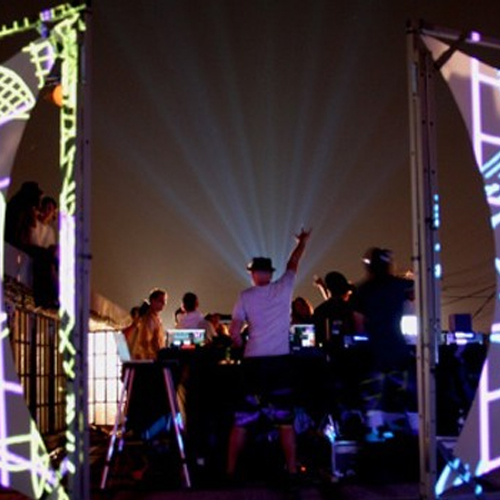






VJing and live A/V practices support a convergence or mixing of the elements of rhythm and movement in sensorial and motorial engagement, from the extended interfaces of sensors used in performance, to mass scale gaming systems like the Nintendo Wii. We also see the process in the making of media work through techniques of software and hardware exposed as part of the work itself. This process becomes performance. – Andrew Bucksbarg, “VJing and Live A/V Practices“
A live video or audio performance happens here, happens now and happens in public. Live audio and DJ (disc jockey, digital jockey) performances are time based sound collages that have long been familiar in popular culture, with roots in hip-hop. Artists like DJ Shadow, DJ Spooky and Girl Talk create collaged soundscapes by remixing existing audio as source material for their on-the-fly compositions. Similarly, a live VJ (video, visual jockey) performance remixes visual source material in front of a live audience. These live mash-ups of moving images often exist alongside a DJ performance and contribute to what is sometimes referred to as a live A/V or live cinema event.
Like many contemporary theater productions, a live audio/visual performance must take into account the elements of time, technology, and the likelihood of an epic failure that may lead to increased tensions with the audience. VJ and DJ artists depend on various high and low technologies for the primary execution of their sets. The primary tool for VJs is their laptop, loaded with VJ software, folders full of audio and video source material, and a keen sense of how to manipulate the software they are working with. The possibility for technological failures outside of the artist’s control are often high and add to the already improvisational essence of a live performance.
In his last book of collected artist writings, META/DATA (MIT Press, 2007), Mark Amerika launched his “Portrait of a VJ” manifesto for live VJ performance:
What a VJ is not:
• A VJ (video/visual jockey) is not an MTV personality.
• A VJ is not a net artist.
• A VJ is not a visual DJ.
• A VJ is not susceptible to computer crashes (i.e. believes in the power of positive
thinking).
What a VJ could be:
• A VJ could be a hyperimprovisational narrative artist who uses banks of quicktime movie clips to construct on-the-fly stories composed of images processed in asynchronous realtime and through various theoretical and performative filters
• A VJ could be a creative writer who manipulates matter and memory by composing live acts of image écriture repositioning the movie loop as the primary semantic unit of energy
• A VJ could be a Tech*know*mad whose fluid Life Style Practice captures consciousness in asynchronous realtime and is forever being remixed into One Ongoing Text Exactly
• A VJ could be a (h)activist provocateur who knowingly intervenes in the mainstream art, club and cinema culture and opens up new possibilities for hybridized art and entertainment events
In remixthebook, Amerika, himself a VJ who has performed his work internationally, philosophically refers to our daily remix rituals as “always live postproduction sets.” For Amerika, as with many other philosophically engaged digital artists and theorists, the act of performing ones ongoing life as a simultaneous and continuous mash-up of the sense data we immerse ourselves in while “making,” is what it means to be alive. In fact, remixthebook suggests that at its root, Darwin’s evolution of the species is about an ancient form of remix culture where, through a process of natural selection and mutation / manipulation, hybridized forms intense aesthetic life survive into the future and seed the ongoing becomingness of the artist as a postproduction medium. Identifying the artist as a role-playing medium who filters information into intense experiences that double as aesthetic facts, enables Amerika to position all “Creativity” in an evolutionary drama driven by the will-to-remix. Without this will-to-remix, life as we know it would cease to exist.
An Elaborate Exercise in Live A/V Performance:
Take your mobile device and begin recording video data that you think would be ideal for live remixing. Remember, colors and shapes are often more interesting than typical street scenes. Sometimes close-ups of things rarely seen or taken seriously are the best source material. If you feel so inclined, give yourself some parameters, such as I will only shoot things that are green, or perfectly square things, or things that move up.
Import all of these video images into your computer and begin editing them into small clips that you can imagine looping in a live performance. Shorter is better. Shorter and visually compelling even better yet.
Take these edited clips and begin experimenting with them in a live VJ mixing program such as VDMX or Resolume. When you feel like you are ready to perform in front of live audience, set up a small gig in a house or apartment or university lab and only invite your friends. What will you do for sound?
Tip: approach this project as a group and assign each member a one hour time-frame to teach everyone else what they have learned. Peer-to-peer learning is always the best when starting with most remix software, and live VJing is no exception.
Questions:
1) How difficult was it for you to follow through on this exercise?
2) Does the process of remixing moving images in a live format change your thinking about art? Is this something you will return to again?
3) Discuss Amerika’s philosophical insights into how our daily remix rituals can be conceived as “always live postproduction sets.” What are some examples of the ways you regularly integrate remix into your daily life?